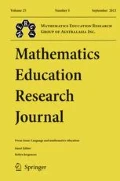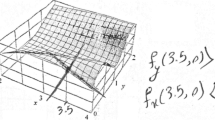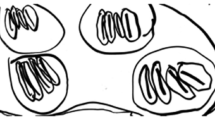Abstract
The aim of this research was to explore the mathematical connections that pre-university students make when they sketch the graph of a derivative function and an antiderivative function. Also, we tried to explain the origin of the mathematical connections identified. We assume mathematical connections as a cognitive process through which a person makes a true relationship between two or more mathematical ideas, concepts, definitions, theorems, or meanings with each other. Task-based interviews were used to collect data which included two graphical tasks that involved the derivative function and the antiderivative function. Through thematic analysis, we identified five types of intra-mathematical connections: procedural, different representations, part-whole, feature, and reversibility, which can serve as a preliminary theoretical framework to study mathematical connections in Calculus in future research; this is a contribution of this research. In addition, results indicated that Mexican students seldom used visualization to solve graphical tasks, so in future research, classroom intervention proposals should be developed to promote the use of visualization including the development of the ability to make mathematical connections, in order to improve their mathematical understanding.




Similar content being viewed by others
Notes
Pre-university level in Mexico includes the 10th, 11th, and 12th grades; it follows Junior High School that includes the 7th, 8th, and 9th grades and Elementary School from 1st to 6th grade. Pre-university level is equivalent to High School in the USA.
We understand visualization as the ability to interpret, use of, and reflect on images on paper, with the purpose of depicting and communicating information (Arcavi 2003). Visualization can be a powerful tool to give meaning to mathematical concepts and identify the relationship (for us, make mathematical connections) between them (Rösken and Rolka 2006).
In Mexico, the numerical scale of evaluation is from 0 to 10. In some pre-university schools (as in the school where this research was done), the minimum passing grade is 6.
We assume that there is a primary belief when someone offers a proposition for which there is no other justification to support it (Green 1971).
These mathematical connections are those that emerge inside mathematics and among mathematical entities (García-García and Dolores-Flores 2018).
References
Adu-Gyamfi, K., Bossé, M. J., & Chandler, K. (2017). Student connections between algebraic and graphical polynomial representations in the context of a polynomial relation. International Journal of Science and Mathematics Education, 15, 915–938.
Ahluwalia, A. (2011). Tracing the building of Robert’s connections in mathematical problem solving: a sixteen year study. Unpublished dissertation, State University of New Jersey United States of America.
Arcavi, A. (2003). The role of visual representations in the learning of mathematics. Educational Studies in Mathematics, 52, 215–241.
Ariza, A., Llinares, S., & Valls, J. (2015). Students’ understanding of the function-derivative relationship when learning economic concepts. Mathematics Education Research Journal, 27, 615–635.
Aspinwall, L., Shaw, K. L., & Presmeg, N. C. (1997). Uncontrollable mental imagery: graphical connections between a function and its derivative. Educational Studies in Mathematics, 33, 301–317.
Baker, B., Cooley, L., & Trigueros, M. (2000). A calculus graphic schema. Journal for Research in Mathematics Education, 3(5), 557–578.
Baki, A., Çatlıoğlu, H., Coştu, S., & Birgin, O. (2009). Conceptions of high school students about mathematical connections to the real-life. Procedia Social and Behavioral Sciences, 1(2009), 1402–1407.
Berry, J., & Nyman, M. (2003). Promoting students’ graphical understanding of the calculus. The Journal of Mathematical Behavior, 22(4), 479–495.
Boaler, J. (2002). Exploring the nature of mathematical activity: using theory, research and ‘working hypotheses’ to broaden conceptions of mathematics knowing. Educational Studies in Mathematics, 51(1–2), 3–21.
Braun, V., & Clarke, V. (2006). Using thematic analysis in psychology. Qualitative Research in Psychology, 3(2), 77–101.
Braun, V., & Clarke, V. (2012). Thematic analysis. In H. Cooper (Ed.), Handbook of research methods in psychology (Vol. 2, pp. 57–71). Washington, DC: American Psychological Association.
Businskas, A. (2008). Conversations about connections: how secondary mathematics teachers conceptualize and contend with mathematical connections. Unpublished dissertation, Faculty of Education, Simon Fraser University, Canada.
Cai, J., & Ding, M. (2015). On mathematical understanding: perspectives of experienced Chinese mathematics teachers. Journal of Mathematics Teachers Education, 18(5), 1–25.
Chigeza, P. (2013). Translating between and within representations: mathematics as lived experiences and interactions. In V. Steinle, L. Ball, & C. Bardini (Eds.), Mathematics Education: Yesterday, today and tomorrow. Proceedings of the 36th annual conference of the mathematics education research group of Australasia (pp. 178–185). Melbourne, VIV: MERGA.
Dawkins, P., & Mendoza, J. (2014). The development and nature of problem-solving among first-semester calculus students. International Journal of Mathematical Education in Science and Technology, 45(6), 839–862.
Dolores-Flores, C., Rivera-López, M. I., & García-García, J. (2019). Exploring mathematical connections of pre-university students through tasks involving rates of change. International Journal of Mathematics Education in Science and Technology, 50(3), 369–389.
Dreher, A., Kuntze, S., & Lerman, S. (2016). Why use multiple representations in the mathematics classroom? Views of English and German preservice teachers. International Journal of Science and Mathematics Education, 14(2), 363–382.
Duval, R. (2006). A cognitive analysis of problems of comprehension in a learning of mathematics. Educational Studies in Mathematics, 61(1), 103–131.
Eli, J., Mohr-Schroeder, M., & Lee, C. (2011). Exploring mathematical connections of prospective middle grades teachers through card-sorting tasks. Mathematics Education Research Journal, 23(3), 297–319.
Eli, J., Mohr-Schroeder, M., & Lee, C. (2013). Mathematical connections and their relationship to mathematics knowledge for teaching geometry. School Science and Mathematics, 113(3), 120–134.
Evitts, T. (2004). Investigating the mathematical connections that preservice teachers use and develop while solving problems from reform curricula. Unpublished dissertation, College of Education, Pennsylvania State University, United States of America.
Francisco, J. M. (2013). The mathematical beliefs and behavior of high school students: Insights from a longitudinal study. Journal of Mathematical Behavior, 32(2013), 481–493.
Gagatsis, A., & Shiakalli, M. (2004). Ability to translate from one representation of the concept of function to another and mathematical problem solving. Educational Psychology, 24(5), 645–657.
García, J. (2018). Conexiones matemáticas y concepciones alternativas asociadas a la derivada y a la integral en estudiantes del preuniversitario [Mathematical connections and alternative conceptions associated with the derivative and the integral in pre-university students]. Unpublished doctoral dissertation, Autonomous University of Guerrero, México.
García-García, J. & Dolores-Flores, C. (2018). Intra-mathematical connections made by high school students in performing Calculus tasks. International Journal of Mathematical Education in Science and Technology, 49(2), 227-252. https://doi.org/10.1080/0020739X.2017.1355994.
Goldin, G. A. (2000). A scientific perspective on structured, task-based interviews in mathematics education research. In A. E. Kelly & R. A. Lesh (Eds.), Handbook of research design in mathematics and science education (pp. 517–545). Mahwah, NJ: Lawrence Erlbaum Associates.
Green, T. F. (1971). The activities of teaching. New York, NY: McGraw-Hill.
Haciomeroglu, E. S. (2007). Calculus students’ understanding of derivative graphs problems of representations in calculus. Unpublished dissertation, College of Education, The Florida State University, United States of America.
Haciomeroglu, E., Aspinwall, L., & Presmeg, N. (2010). Contrasting cases of calculus students’ understanding of derivative graphs. Mathematical Thinking and Learning, 12(2), 152–176.
Hiebert, J., & Carpenter, T. (1992). Learning and teaching with understanding. In D. A. Grouws (Ed.), Handbook of research of mathematics teaching and learning (pp. 65–79). New York, NY: Macmillan.
Hong, Y., & Thomas, M. (2015). Graphical construction of a local perspective on differentiation and integration. Mathematics Education Research Journal, 27(2), 183–200.
Iqbal, M. Z., Mirza, M. S., & Shams, J. A. (2017). Changes in students’ beliefs: a case of mathematics. Bulletin of Education and Research, 39(3), 93–103.
Ji-Eun, L. (2012). Prospective elementary teachers’ perceptions of real-life connections reflected in posing and evaluating story problems. Journal Mathematics of Teacher Education, 15, 429–452.
Karakoç, G., & Alacacı, C. (2015). Real world connections in high school mathematics curriculum and teaching. Turkish Journal of Computer and Mathematics Education, 6(1), 31–46.
Kastberg, S. E. (2002). Understanding mathematical concepts: the case of the logarithmic function. Unpublished dissertation, University of Georgia. United States of America.
Lesh, R., Post, T., & Behr, M. (1987). Representations and translations among representations in mathematics learning and problem solving. In C. Janvier (Ed.), Problems of representations in the teaching and learning of mathematics (pp. 33–40). Hillsdale, NJ: Lawrence Erlbaum.
McGee, D. L., & Martinez-Planell, R. (2014). A study of semiotic registers in the development of the definite integral of functions of two and three variables. International Journal of Science and Mathematics Education, 12, 883–916.
Mhlolo, M. (2012). Mathematical connections of a higher cognitive level: a tool we may use to identify these in practice. African Journal of Research in Mathematics, Science and Technology, 16(2), 176–191.
Moon, K., Brenner, M., Jacob, B., & Okamoto, Y. (2013). Prospective secondary mathematics teachers’ understanding and cognitive difficulties in making connections among representations. Mathematical Thinking and Learning, 15(3), 201–227.
Natsheh, I., & Karsenty, R. (2014). Exploring the potential role of visual reasoning tasks among inexperienced solvers. ZDM Mathematics Education, 46, 109–122.
NCTM. (2000). Principles and standards for school mathematics. Reston, VA: National Council of Teachers of Mathematics.
Özgen, K. (2013). Problem çözme bağlaminda matematiksel ilişkilendirme becerisi: öğretmen adaylari örneği [Mathematical connection skill in the context of problem solving: the case of pre-service teachers]. NWSA-Education Sciences, 8(3), 323–345.
Philipp, R. A. (2007). Mathematics teachers’ beliefs and affect. In F. Lester (Ed.), Handbook of research on mathematics teaching and learning (pp. 257–315). Charlotte, NC: Information Age Publishing.
Rokeach, M. (1968). Beliefs, attitudes and values: a theory of organization and change. San Francisco: Jossey-Bass.
Rösken, B., & Rolka, K. (2006). A picture is worth a 1000 words – the role of visualization in mathematics learning. In J. Novotná, H. Moraová, M. Krátká, & N. Stehlíková (Eds.), Proceedings 30th conference of the International Group for the Psychology of mathematics education (Vol. 4, pp. 457–464). PME: Prague.
Schoenfeld, A. H. (1998). Toward a theory of teaching in context. Issues in Education, 4(1), 1–94.
SEP. (2013a). Cálculo diferencial [Differential calculus]. Obtained on June 10, 2015 from: http://www.dgb.sep.gob.mx/informacion-academica/programas-de-estudio/cfp_5sem/calculo-diferencial.pdf
SEP. (2013b). Cálculo Integral [Integral calculus]. Obtained on June 10, 2015 from: http://www.dgb.sep.gob.mx/informacion-academica/programas-de-estudio/cfp_6sem/CALCULO_INTEGRAL.pdf
Soltani, S. H., Mohammad-Hassan, B., Shahvarani, A., & Manuchehri, M. (2013). Students’ conception about the relation of mathematics to real-life. Mathematics Education Trends and Research, 2013(2013), 1–7.
Stephen, J. P., & Mourat, A. T. (2001). The role of representation(s) in developing mathematical understanding. Theory Into Practice, 40(2), 118–127.
Ubuz, B. (2007). Interpreting a graph and constructing its derivative graph: stability and change in students’ conceptions. International Journal of Mathematical Education in Science and Technology, 38(5), 609–637.
Author information
Authors and Affiliations
Corresponding author
Additional information
Publisher’s note
Springerx Nature remains neutral with regard to jurisdictional claims in published maps and institutional affiliations.
Rights and permissions
About this article
Cite this article
García-García, J., Dolores-Flores, C. Pre-university students’ mathematical connections when sketching the graph of derivative and antiderivative functions. Math Ed Res J 33, 1–22 (2021). https://doi.org/10.1007/s13394-019-00286-x
Received:
Revised:
Accepted:
Published:
Issue Date:
DOI: https://doi.org/10.1007/s13394-019-00286-x




